Nottingham Factory Case Study: A Deep Dive into Business Challenges
VerifiedAdded on 2023/06/15
|11
|3018
|132
Case Study
AI Summary
This case study examines the challenges faced by the Nottingham Factory, a fabric dyeing business owned by Henry Chaplin and later managed by his son Richard. The factory grapples with issues including a lack of clear management strategy, inefficient human resource management, supply chain problems, financial instability, communication breakdowns, intense competition, and leadership deficits. Richard's aggressive management style and inconsistent decisions erode employee trust and contribute to high turnover. The factory struggles with supplier relationships, financial transparency, and adapting to market competition, resulting in declining profitability and brand loyalty. Addressing these multifaceted issues requires a comprehensive overhaul of management practices, financial strategies, and communication protocols to restore employee morale, improve supplier relations, and regain a competitive edge.
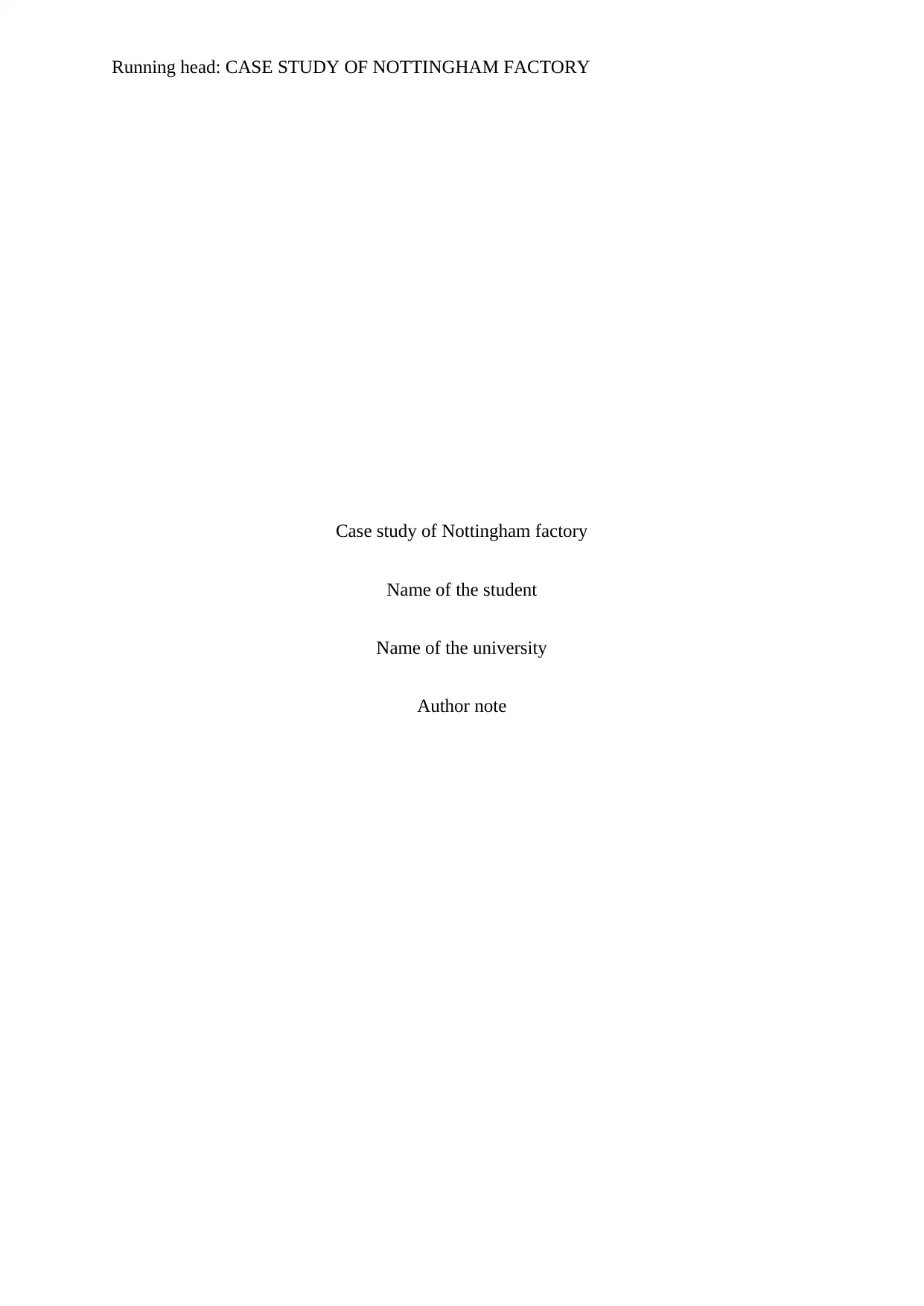
Running head: CASE STUDY OF NOTTINGHAM FACTORY
Case study of Nottingham factory
Name of the student
Name of the university
Author note
Case study of Nottingham factory
Name of the student
Name of the university
Author note
Paraphrase This Document
Need a fresh take? Get an instant paraphrase of this document with our AI Paraphraser
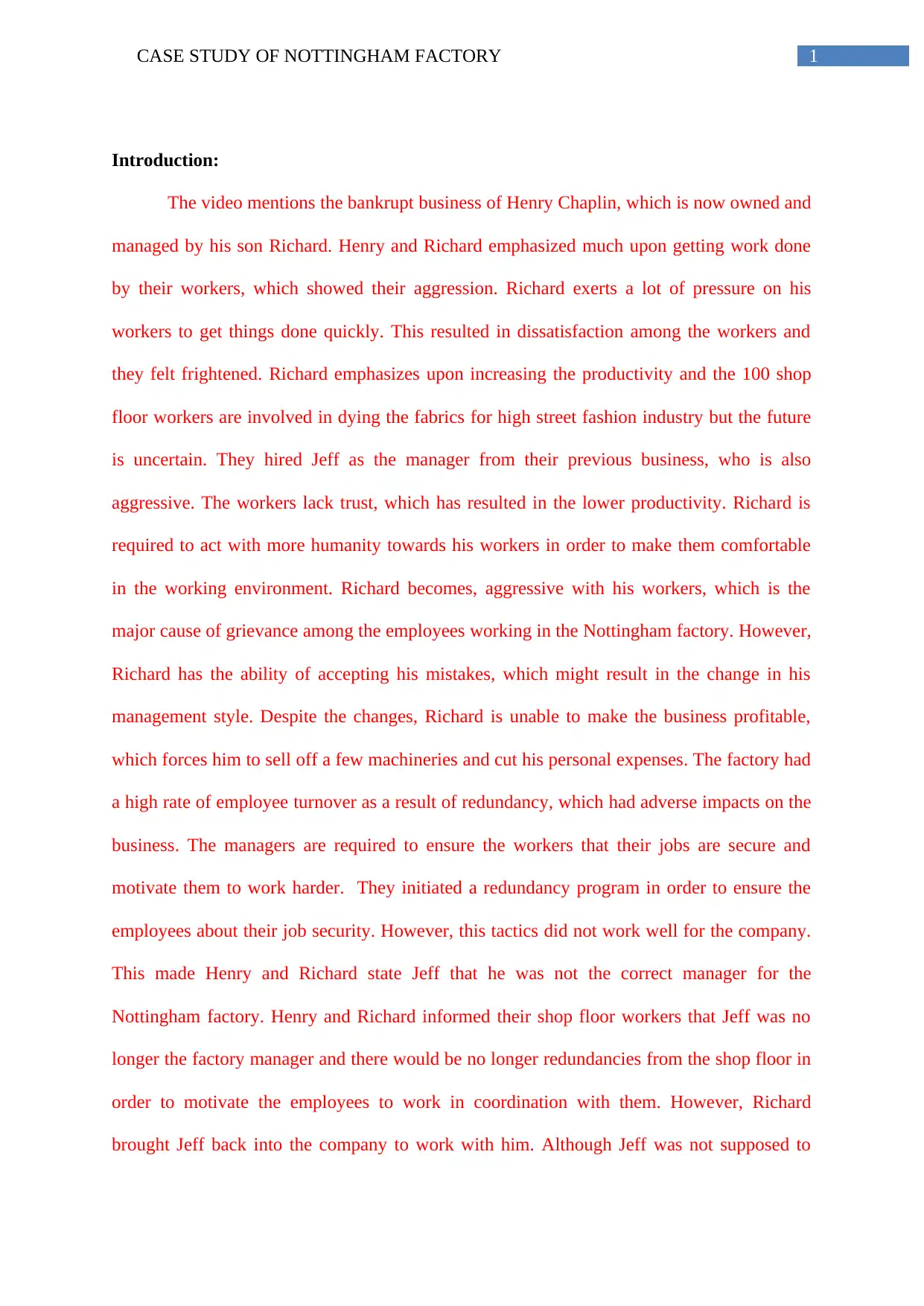
1CASE STUDY OF NOTTINGHAM FACTORY
Introduction:
The video mentions the bankrupt business of Henry Chaplin, which is now owned and
managed by his son Richard. Henry and Richard emphasized much upon getting work done
by their workers, which showed their aggression. Richard exerts a lot of pressure on his
workers to get things done quickly. This resulted in dissatisfaction among the workers and
they felt frightened. Richard emphasizes upon increasing the productivity and the 100 shop
floor workers are involved in dying the fabrics for high street fashion industry but the future
is uncertain. They hired Jeff as the manager from their previous business, who is also
aggressive. The workers lack trust, which has resulted in the lower productivity. Richard is
required to act with more humanity towards his workers in order to make them comfortable
in the working environment. Richard becomes, aggressive with his workers, which is the
major cause of grievance among the employees working in the Nottingham factory. However,
Richard has the ability of accepting his mistakes, which might result in the change in his
management style. Despite the changes, Richard is unable to make the business profitable,
which forces him to sell off a few machineries and cut his personal expenses. The factory had
a high rate of employee turnover as a result of redundancy, which had adverse impacts on the
business. The managers are required to ensure the workers that their jobs are secure and
motivate them to work harder. They initiated a redundancy program in order to ensure the
employees about their job security. However, this tactics did not work well for the company.
This made Henry and Richard state Jeff that he was not the correct manager for the
Nottingham factory. Henry and Richard informed their shop floor workers that Jeff was no
longer the factory manager and there would be no longer redundancies from the shop floor in
order to motivate the employees to work in coordination with them. However, Richard
brought Jeff back into the company to work with him. Although Jeff was not supposed to
Introduction:
The video mentions the bankrupt business of Henry Chaplin, which is now owned and
managed by his son Richard. Henry and Richard emphasized much upon getting work done
by their workers, which showed their aggression. Richard exerts a lot of pressure on his
workers to get things done quickly. This resulted in dissatisfaction among the workers and
they felt frightened. Richard emphasizes upon increasing the productivity and the 100 shop
floor workers are involved in dying the fabrics for high street fashion industry but the future
is uncertain. They hired Jeff as the manager from their previous business, who is also
aggressive. The workers lack trust, which has resulted in the lower productivity. Richard is
required to act with more humanity towards his workers in order to make them comfortable
in the working environment. Richard becomes, aggressive with his workers, which is the
major cause of grievance among the employees working in the Nottingham factory. However,
Richard has the ability of accepting his mistakes, which might result in the change in his
management style. Despite the changes, Richard is unable to make the business profitable,
which forces him to sell off a few machineries and cut his personal expenses. The factory had
a high rate of employee turnover as a result of redundancy, which had adverse impacts on the
business. The managers are required to ensure the workers that their jobs are secure and
motivate them to work harder. They initiated a redundancy program in order to ensure the
employees about their job security. However, this tactics did not work well for the company.
This made Henry and Richard state Jeff that he was not the correct manager for the
Nottingham factory. Henry and Richard informed their shop floor workers that Jeff was no
longer the factory manager and there would be no longer redundancies from the shop floor in
order to motivate the employees to work in coordination with them. However, Richard
brought Jeff back into the company to work with him. Although Jeff was not supposed to
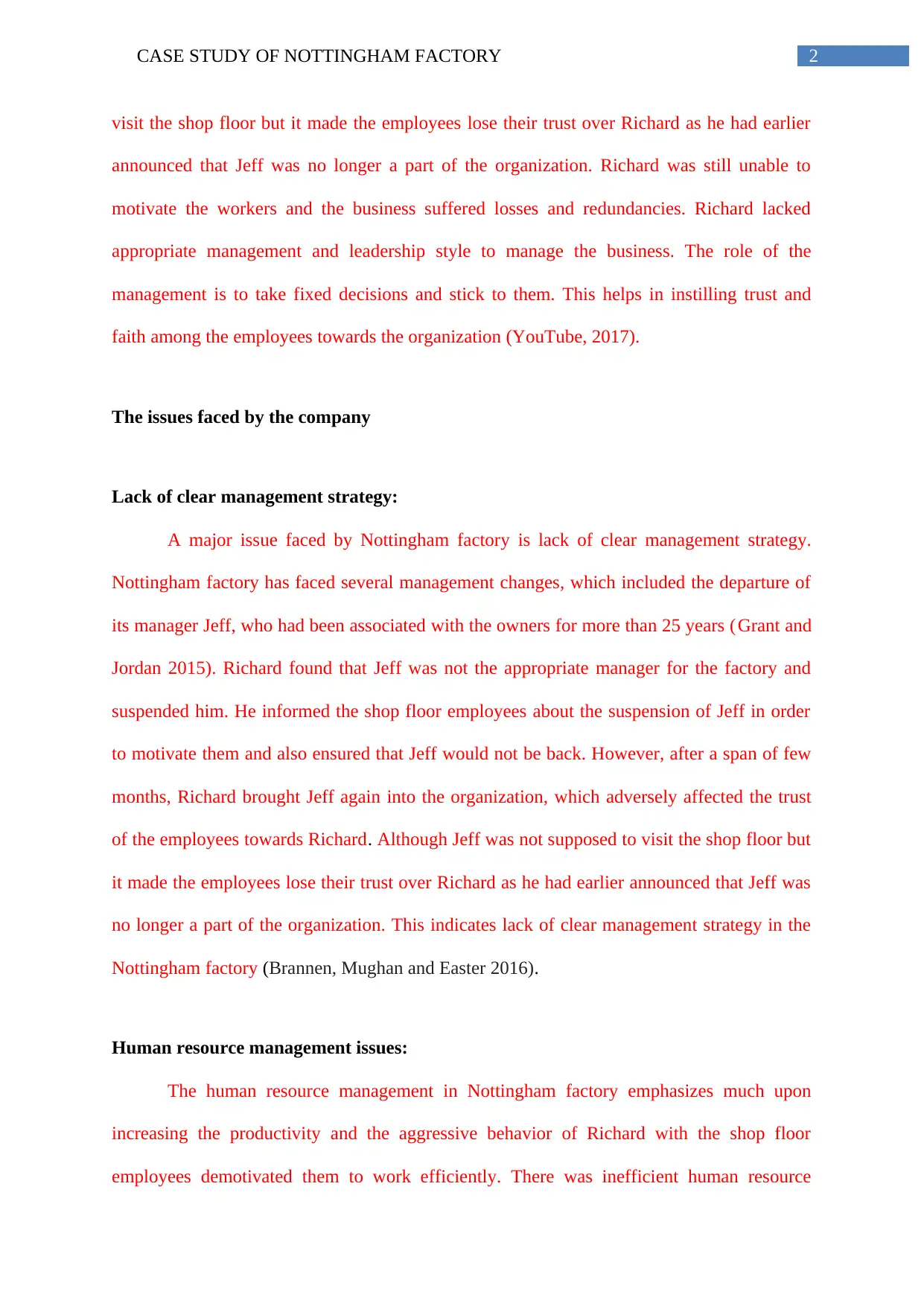
2CASE STUDY OF NOTTINGHAM FACTORY
visit the shop floor but it made the employees lose their trust over Richard as he had earlier
announced that Jeff was no longer a part of the organization. Richard was still unable to
motivate the workers and the business suffered losses and redundancies. Richard lacked
appropriate management and leadership style to manage the business. The role of the
management is to take fixed decisions and stick to them. This helps in instilling trust and
faith among the employees towards the organization (YouTube, 2017).
The issues faced by the company
Lack of clear management strategy:
A major issue faced by Nottingham factory is lack of clear management strategy.
Nottingham factory has faced several management changes, which included the departure of
its manager Jeff, who had been associated with the owners for more than 25 years (Grant and
Jordan 2015). Richard found that Jeff was not the appropriate manager for the factory and
suspended him. He informed the shop floor employees about the suspension of Jeff in order
to motivate them and also ensured that Jeff would not be back. However, after a span of few
months, Richard brought Jeff again into the organization, which adversely affected the trust
of the employees towards Richard. Although Jeff was not supposed to visit the shop floor but
it made the employees lose their trust over Richard as he had earlier announced that Jeff was
no longer a part of the organization. This indicates lack of clear management strategy in the
Nottingham factory (Brannen, Mughan and Easter 2016).
Human resource management issues:
The human resource management in Nottingham factory emphasizes much upon
increasing the productivity and the aggressive behavior of Richard with the shop floor
employees demotivated them to work efficiently. There was inefficient human resource
visit the shop floor but it made the employees lose their trust over Richard as he had earlier
announced that Jeff was no longer a part of the organization. Richard was still unable to
motivate the workers and the business suffered losses and redundancies. Richard lacked
appropriate management and leadership style to manage the business. The role of the
management is to take fixed decisions and stick to them. This helps in instilling trust and
faith among the employees towards the organization (YouTube, 2017).
The issues faced by the company
Lack of clear management strategy:
A major issue faced by Nottingham factory is lack of clear management strategy.
Nottingham factory has faced several management changes, which included the departure of
its manager Jeff, who had been associated with the owners for more than 25 years (Grant and
Jordan 2015). Richard found that Jeff was not the appropriate manager for the factory and
suspended him. He informed the shop floor employees about the suspension of Jeff in order
to motivate them and also ensured that Jeff would not be back. However, after a span of few
months, Richard brought Jeff again into the organization, which adversely affected the trust
of the employees towards Richard. Although Jeff was not supposed to visit the shop floor but
it made the employees lose their trust over Richard as he had earlier announced that Jeff was
no longer a part of the organization. This indicates lack of clear management strategy in the
Nottingham factory (Brannen, Mughan and Easter 2016).
Human resource management issues:
The human resource management in Nottingham factory emphasizes much upon
increasing the productivity and the aggressive behavior of Richard with the shop floor
employees demotivated them to work efficiently. There was inefficient human resource
⊘ This is a preview!⊘
Do you want full access?
Subscribe today to unlock all pages.

Trusted by 1+ million students worldwide
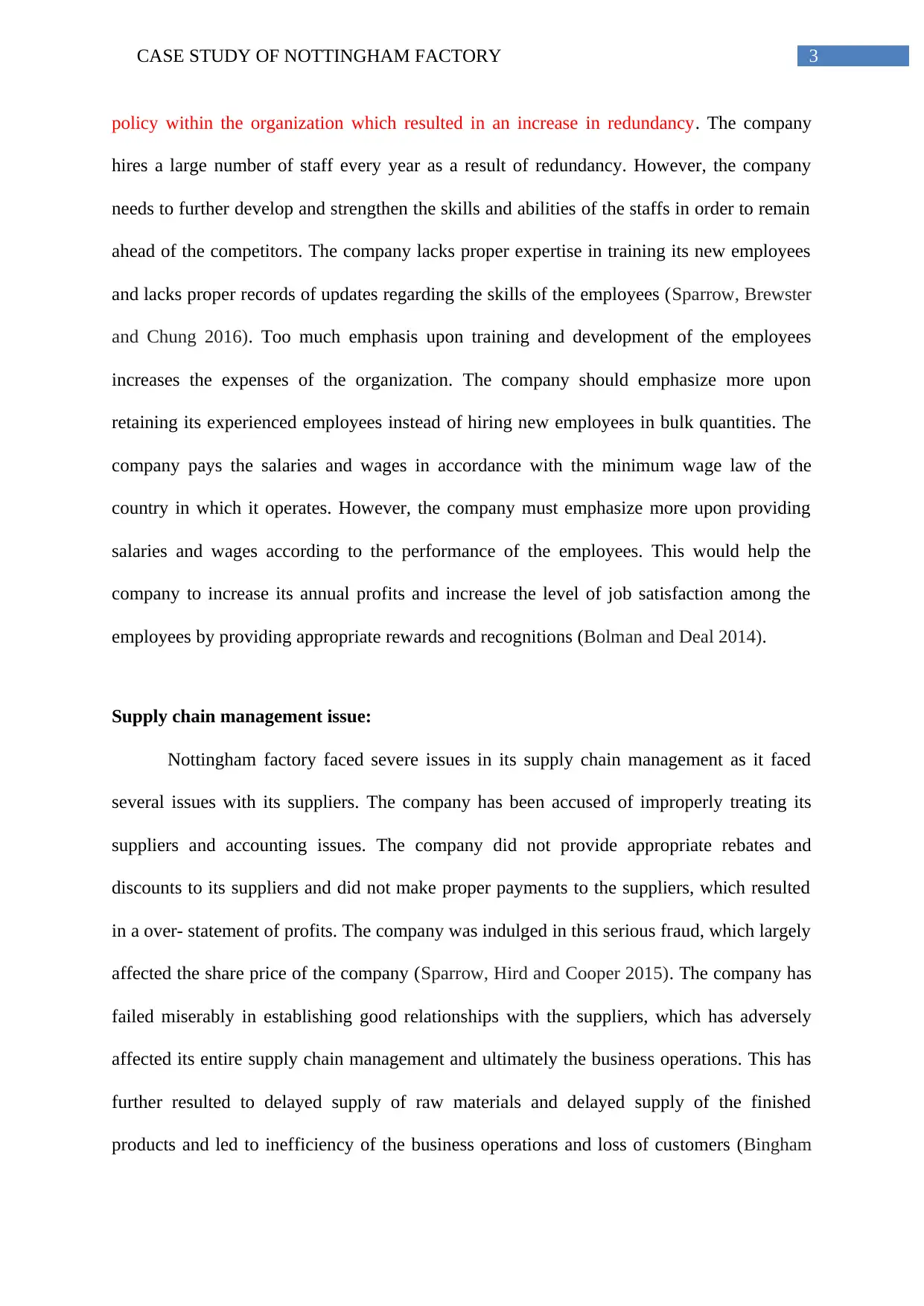
3CASE STUDY OF NOTTINGHAM FACTORY
policy within the organization which resulted in an increase in redundancy. The company
hires a large number of staff every year as a result of redundancy. However, the company
needs to further develop and strengthen the skills and abilities of the staffs in order to remain
ahead of the competitors. The company lacks proper expertise in training its new employees
and lacks proper records of updates regarding the skills of the employees (Sparrow, Brewster
and Chung 2016). Too much emphasis upon training and development of the employees
increases the expenses of the organization. The company should emphasize more upon
retaining its experienced employees instead of hiring new employees in bulk quantities. The
company pays the salaries and wages in accordance with the minimum wage law of the
country in which it operates. However, the company must emphasize more upon providing
salaries and wages according to the performance of the employees. This would help the
company to increase its annual profits and increase the level of job satisfaction among the
employees by providing appropriate rewards and recognitions (Bolman and Deal 2014).
Supply chain management issue:
Nottingham factory faced severe issues in its supply chain management as it faced
several issues with its suppliers. The company has been accused of improperly treating its
suppliers and accounting issues. The company did not provide appropriate rebates and
discounts to its suppliers and did not make proper payments to the suppliers, which resulted
in a over- statement of profits. The company was indulged in this serious fraud, which largely
affected the share price of the company (Sparrow, Hird and Cooper 2015). The company has
failed miserably in establishing good relationships with the suppliers, which has adversely
affected its entire supply chain management and ultimately the business operations. This has
further resulted to delayed supply of raw materials and delayed supply of the finished
products and led to inefficiency of the business operations and loss of customers (Bingham
policy within the organization which resulted in an increase in redundancy. The company
hires a large number of staff every year as a result of redundancy. However, the company
needs to further develop and strengthen the skills and abilities of the staffs in order to remain
ahead of the competitors. The company lacks proper expertise in training its new employees
and lacks proper records of updates regarding the skills of the employees (Sparrow, Brewster
and Chung 2016). Too much emphasis upon training and development of the employees
increases the expenses of the organization. The company should emphasize more upon
retaining its experienced employees instead of hiring new employees in bulk quantities. The
company pays the salaries and wages in accordance with the minimum wage law of the
country in which it operates. However, the company must emphasize more upon providing
salaries and wages according to the performance of the employees. This would help the
company to increase its annual profits and increase the level of job satisfaction among the
employees by providing appropriate rewards and recognitions (Bolman and Deal 2014).
Supply chain management issue:
Nottingham factory faced severe issues in its supply chain management as it faced
several issues with its suppliers. The company has been accused of improperly treating its
suppliers and accounting issues. The company did not provide appropriate rebates and
discounts to its suppliers and did not make proper payments to the suppliers, which resulted
in a over- statement of profits. The company was indulged in this serious fraud, which largely
affected the share price of the company (Sparrow, Hird and Cooper 2015). The company has
failed miserably in establishing good relationships with the suppliers, which has adversely
affected its entire supply chain management and ultimately the business operations. This has
further resulted to delayed supply of raw materials and delayed supply of the finished
products and led to inefficiency of the business operations and loss of customers (Bingham
Paraphrase This Document
Need a fresh take? Get an instant paraphrase of this document with our AI Paraphraser
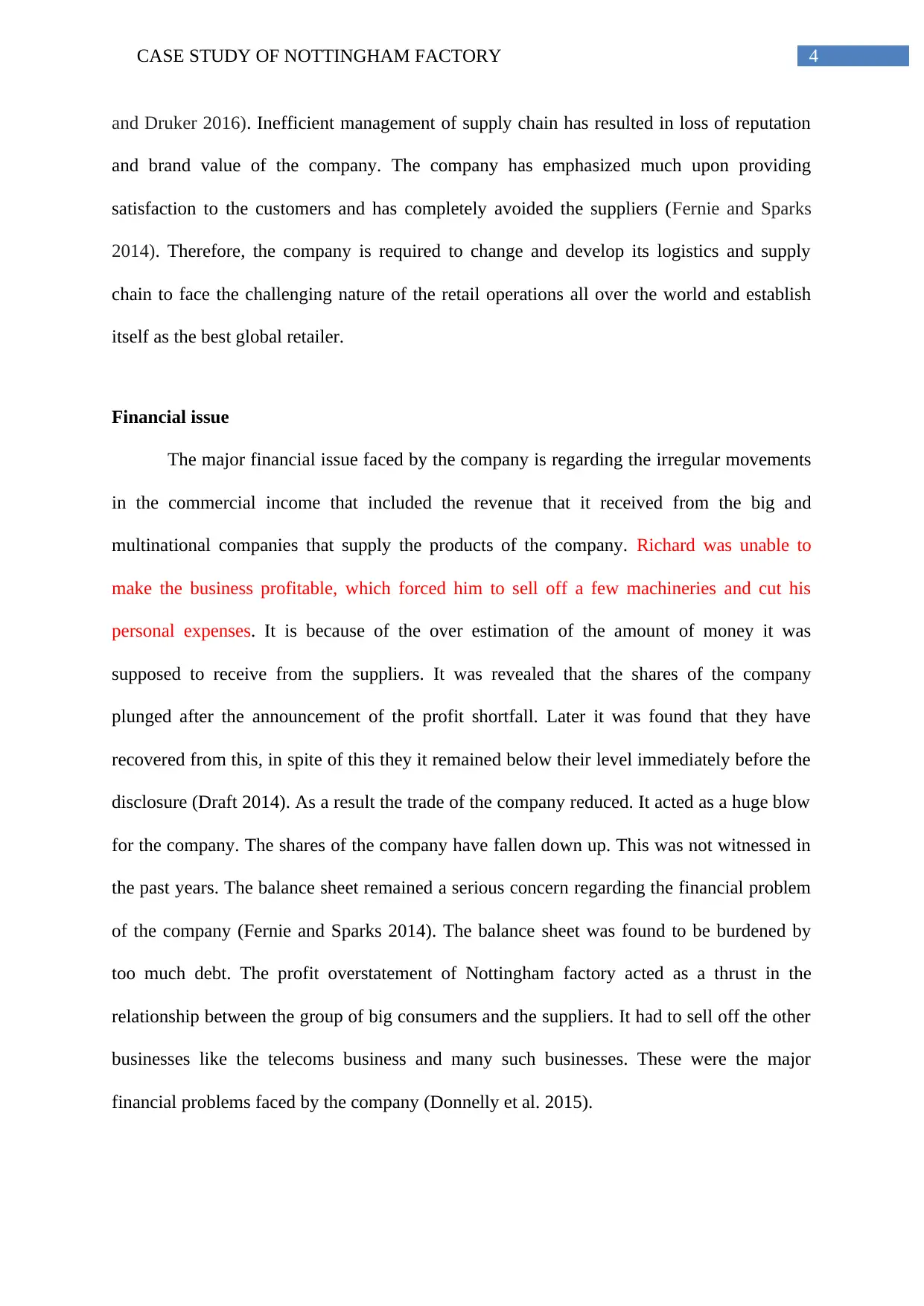
4CASE STUDY OF NOTTINGHAM FACTORY
and Druker 2016). Inefficient management of supply chain has resulted in loss of reputation
and brand value of the company. The company has emphasized much upon providing
satisfaction to the customers and has completely avoided the suppliers (Fernie and Sparks
2014). Therefore, the company is required to change and develop its logistics and supply
chain to face the challenging nature of the retail operations all over the world and establish
itself as the best global retailer.
Financial issue
The major financial issue faced by the company is regarding the irregular movements
in the commercial income that included the revenue that it received from the big and
multinational companies that supply the products of the company. Richard was unable to
make the business profitable, which forced him to sell off a few machineries and cut his
personal expenses. It is because of the over estimation of the amount of money it was
supposed to receive from the suppliers. It was revealed that the shares of the company
plunged after the announcement of the profit shortfall. Later it was found that they have
recovered from this, in spite of this they it remained below their level immediately before the
disclosure (Draft 2014). As a result the trade of the company reduced. It acted as a huge blow
for the company. The shares of the company have fallen down up. This was not witnessed in
the past years. The balance sheet remained a serious concern regarding the financial problem
of the company (Fernie and Sparks 2014). The balance sheet was found to be burdened by
too much debt. The profit overstatement of Nottingham factory acted as a thrust in the
relationship between the group of big consumers and the suppliers. It had to sell off the other
businesses like the telecoms business and many such businesses. These were the major
financial problems faced by the company (Donnelly et al. 2015).
and Druker 2016). Inefficient management of supply chain has resulted in loss of reputation
and brand value of the company. The company has emphasized much upon providing
satisfaction to the customers and has completely avoided the suppliers (Fernie and Sparks
2014). Therefore, the company is required to change and develop its logistics and supply
chain to face the challenging nature of the retail operations all over the world and establish
itself as the best global retailer.
Financial issue
The major financial issue faced by the company is regarding the irregular movements
in the commercial income that included the revenue that it received from the big and
multinational companies that supply the products of the company. Richard was unable to
make the business profitable, which forced him to sell off a few machineries and cut his
personal expenses. It is because of the over estimation of the amount of money it was
supposed to receive from the suppliers. It was revealed that the shares of the company
plunged after the announcement of the profit shortfall. Later it was found that they have
recovered from this, in spite of this they it remained below their level immediately before the
disclosure (Draft 2014). As a result the trade of the company reduced. It acted as a huge blow
for the company. The shares of the company have fallen down up. This was not witnessed in
the past years. The balance sheet remained a serious concern regarding the financial problem
of the company (Fernie and Sparks 2014). The balance sheet was found to be burdened by
too much debt. The profit overstatement of Nottingham factory acted as a thrust in the
relationship between the group of big consumers and the suppliers. It had to sell off the other
businesses like the telecoms business and many such businesses. These were the major
financial problems faced by the company (Donnelly et al. 2015).
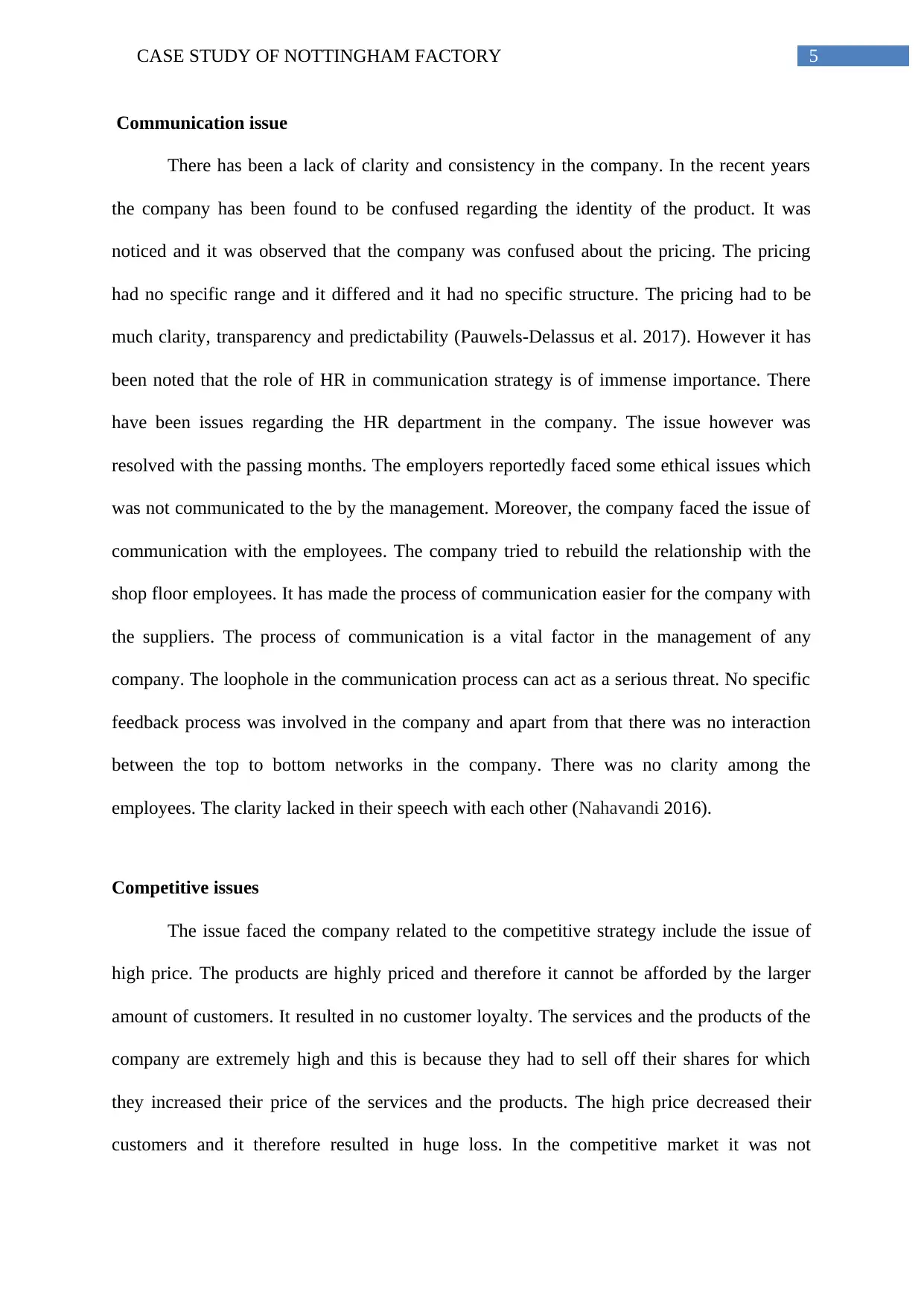
5CASE STUDY OF NOTTINGHAM FACTORY
Communication issue
There has been a lack of clarity and consistency in the company. In the recent years
the company has been found to be confused regarding the identity of the product. It was
noticed and it was observed that the company was confused about the pricing. The pricing
had no specific range and it differed and it had no specific structure. The pricing had to be
much clarity, transparency and predictability (Pauwels-Delassus et al. 2017). However it has
been noted that the role of HR in communication strategy is of immense importance. There
have been issues regarding the HR department in the company. The issue however was
resolved with the passing months. The employers reportedly faced some ethical issues which
was not communicated to the by the management. Moreover, the company faced the issue of
communication with the employees. The company tried to rebuild the relationship with the
shop floor employees. It has made the process of communication easier for the company with
the suppliers. The process of communication is a vital factor in the management of any
company. The loophole in the communication process can act as a serious threat. No specific
feedback process was involved in the company and apart from that there was no interaction
between the top to bottom networks in the company. There was no clarity among the
employees. The clarity lacked in their speech with each other (Nahavandi 2016).
Competitive issues
The issue faced the company related to the competitive strategy include the issue of
high price. The products are highly priced and therefore it cannot be afforded by the larger
amount of customers. It resulted in no customer loyalty. The services and the products of the
company are extremely high and this is because they had to sell off their shares for which
they increased their price of the services and the products. The high price decreased their
customers and it therefore resulted in huge loss. In the competitive market it was not
Communication issue
There has been a lack of clarity and consistency in the company. In the recent years
the company has been found to be confused regarding the identity of the product. It was
noticed and it was observed that the company was confused about the pricing. The pricing
had no specific range and it differed and it had no specific structure. The pricing had to be
much clarity, transparency and predictability (Pauwels-Delassus et al. 2017). However it has
been noted that the role of HR in communication strategy is of immense importance. There
have been issues regarding the HR department in the company. The issue however was
resolved with the passing months. The employers reportedly faced some ethical issues which
was not communicated to the by the management. Moreover, the company faced the issue of
communication with the employees. The company tried to rebuild the relationship with the
shop floor employees. It has made the process of communication easier for the company with
the suppliers. The process of communication is a vital factor in the management of any
company. The loophole in the communication process can act as a serious threat. No specific
feedback process was involved in the company and apart from that there was no interaction
between the top to bottom networks in the company. There was no clarity among the
employees. The clarity lacked in their speech with each other (Nahavandi 2016).
Competitive issues
The issue faced the company related to the competitive strategy include the issue of
high price. The products are highly priced and therefore it cannot be afforded by the larger
amount of customers. It resulted in no customer loyalty. The services and the products of the
company are extremely high and this is because they had to sell off their shares for which
they increased their price of the services and the products. The high price decreased their
customers and it therefore resulted in huge loss. In the competitive market it was not
⊘ This is a preview!⊘
Do you want full access?
Subscribe today to unlock all pages.

Trusted by 1+ million students worldwide
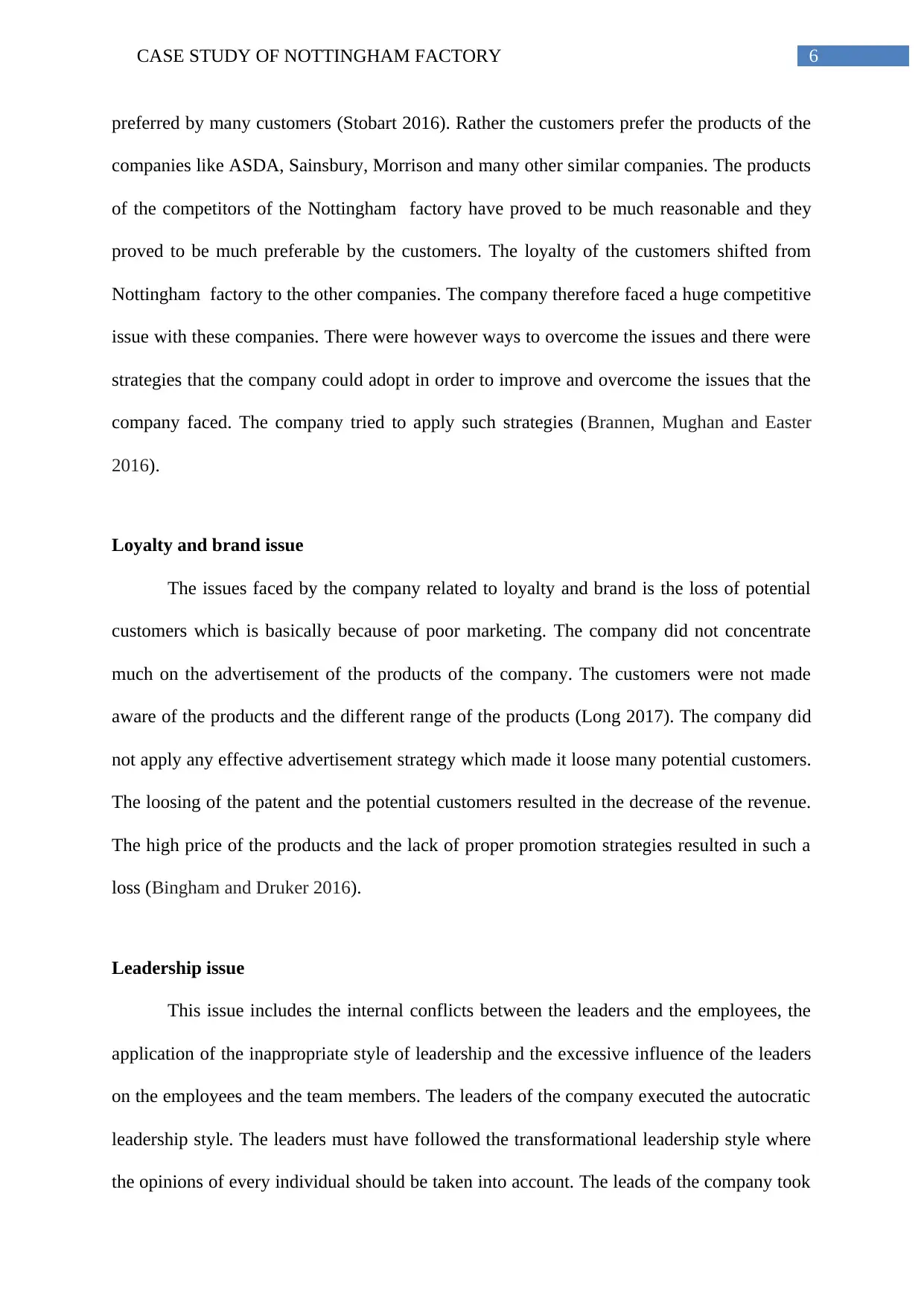
6CASE STUDY OF NOTTINGHAM FACTORY
preferred by many customers (Stobart 2016). Rather the customers prefer the products of the
companies like ASDA, Sainsbury, Morrison and many other similar companies. The products
of the competitors of the Nottingham factory have proved to be much reasonable and they
proved to be much preferable by the customers. The loyalty of the customers shifted from
Nottingham factory to the other companies. The company therefore faced a huge competitive
issue with these companies. There were however ways to overcome the issues and there were
strategies that the company could adopt in order to improve and overcome the issues that the
company faced. The company tried to apply such strategies (Brannen, Mughan and Easter
2016).
Loyalty and brand issue
The issues faced by the company related to loyalty and brand is the loss of potential
customers which is basically because of poor marketing. The company did not concentrate
much on the advertisement of the products of the company. The customers were not made
aware of the products and the different range of the products (Long 2017). The company did
not apply any effective advertisement strategy which made it loose many potential customers.
The loosing of the patent and the potential customers resulted in the decrease of the revenue.
The high price of the products and the lack of proper promotion strategies resulted in such a
loss (Bingham and Druker 2016).
Leadership issue
This issue includes the internal conflicts between the leaders and the employees, the
application of the inappropriate style of leadership and the excessive influence of the leaders
on the employees and the team members. The leaders of the company executed the autocratic
leadership style. The leaders must have followed the transformational leadership style where
the opinions of every individual should be taken into account. The leads of the company took
preferred by many customers (Stobart 2016). Rather the customers prefer the products of the
companies like ASDA, Sainsbury, Morrison and many other similar companies. The products
of the competitors of the Nottingham factory have proved to be much reasonable and they
proved to be much preferable by the customers. The loyalty of the customers shifted from
Nottingham factory to the other companies. The company therefore faced a huge competitive
issue with these companies. There were however ways to overcome the issues and there were
strategies that the company could adopt in order to improve and overcome the issues that the
company faced. The company tried to apply such strategies (Brannen, Mughan and Easter
2016).
Loyalty and brand issue
The issues faced by the company related to loyalty and brand is the loss of potential
customers which is basically because of poor marketing. The company did not concentrate
much on the advertisement of the products of the company. The customers were not made
aware of the products and the different range of the products (Long 2017). The company did
not apply any effective advertisement strategy which made it loose many potential customers.
The loosing of the patent and the potential customers resulted in the decrease of the revenue.
The high price of the products and the lack of proper promotion strategies resulted in such a
loss (Bingham and Druker 2016).
Leadership issue
This issue includes the internal conflicts between the leaders and the employees, the
application of the inappropriate style of leadership and the excessive influence of the leaders
on the employees and the team members. The leaders of the company executed the autocratic
leadership style. The leaders must have followed the transformational leadership style where
the opinions of every individual should be taken into account. The leads of the company took
Paraphrase This Document
Need a fresh take? Get an instant paraphrase of this document with our AI Paraphraser
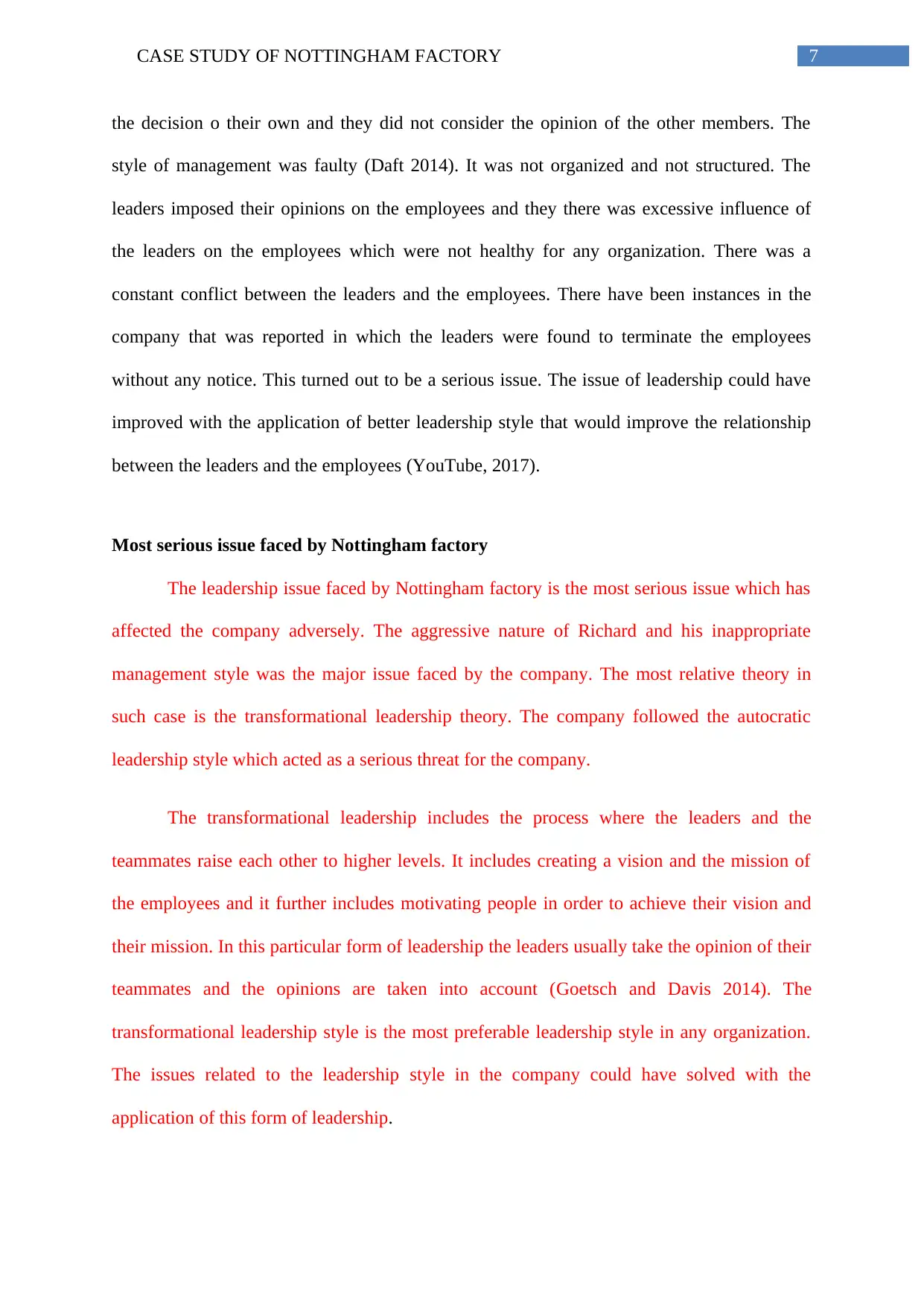
7CASE STUDY OF NOTTINGHAM FACTORY
the decision o their own and they did not consider the opinion of the other members. The
style of management was faulty (Daft 2014). It was not organized and not structured. The
leaders imposed their opinions on the employees and they there was excessive influence of
the leaders on the employees which were not healthy for any organization. There was a
constant conflict between the leaders and the employees. There have been instances in the
company that was reported in which the leaders were found to terminate the employees
without any notice. This turned out to be a serious issue. The issue of leadership could have
improved with the application of better leadership style that would improve the relationship
between the leaders and the employees (YouTube, 2017).
Most serious issue faced by Nottingham factory
The leadership issue faced by Nottingham factory is the most serious issue which has
affected the company adversely. The aggressive nature of Richard and his inappropriate
management style was the major issue faced by the company. The most relative theory in
such case is the transformational leadership theory. The company followed the autocratic
leadership style which acted as a serious threat for the company.
The transformational leadership includes the process where the leaders and the
teammates raise each other to higher levels. It includes creating a vision and the mission of
the employees and it further includes motivating people in order to achieve their vision and
their mission. In this particular form of leadership the leaders usually take the opinion of their
teammates and the opinions are taken into account (Goetsch and Davis 2014). The
transformational leadership style is the most preferable leadership style in any organization.
The issues related to the leadership style in the company could have solved with the
application of this form of leadership.
the decision o their own and they did not consider the opinion of the other members. The
style of management was faulty (Daft 2014). It was not organized and not structured. The
leaders imposed their opinions on the employees and they there was excessive influence of
the leaders on the employees which were not healthy for any organization. There was a
constant conflict between the leaders and the employees. There have been instances in the
company that was reported in which the leaders were found to terminate the employees
without any notice. This turned out to be a serious issue. The issue of leadership could have
improved with the application of better leadership style that would improve the relationship
between the leaders and the employees (YouTube, 2017).
Most serious issue faced by Nottingham factory
The leadership issue faced by Nottingham factory is the most serious issue which has
affected the company adversely. The aggressive nature of Richard and his inappropriate
management style was the major issue faced by the company. The most relative theory in
such case is the transformational leadership theory. The company followed the autocratic
leadership style which acted as a serious threat for the company.
The transformational leadership includes the process where the leaders and the
teammates raise each other to higher levels. It includes creating a vision and the mission of
the employees and it further includes motivating people in order to achieve their vision and
their mission. In this particular form of leadership the leaders usually take the opinion of their
teammates and the opinions are taken into account (Goetsch and Davis 2014). The
transformational leadership style is the most preferable leadership style in any organization.
The issues related to the leadership style in the company could have solved with the
application of this form of leadership.
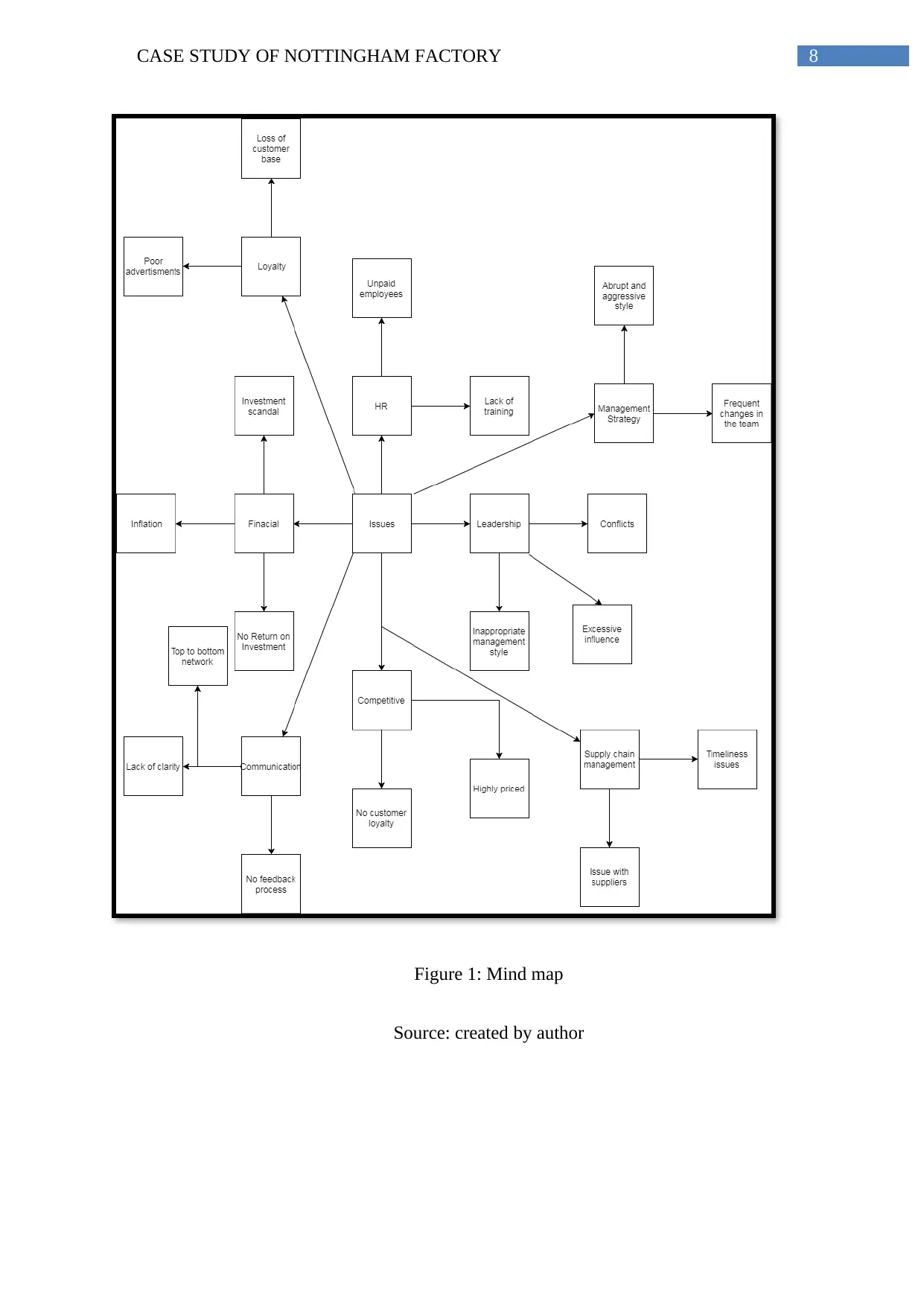
8CASE STUDY OF NOTTINGHAM FACTORY
Figure 1: Mind map
Source: created by author
Figure 1: Mind map
Source: created by author
⊘ This is a preview!⊘
Do you want full access?
Subscribe today to unlock all pages.

Trusted by 1+ million students worldwide
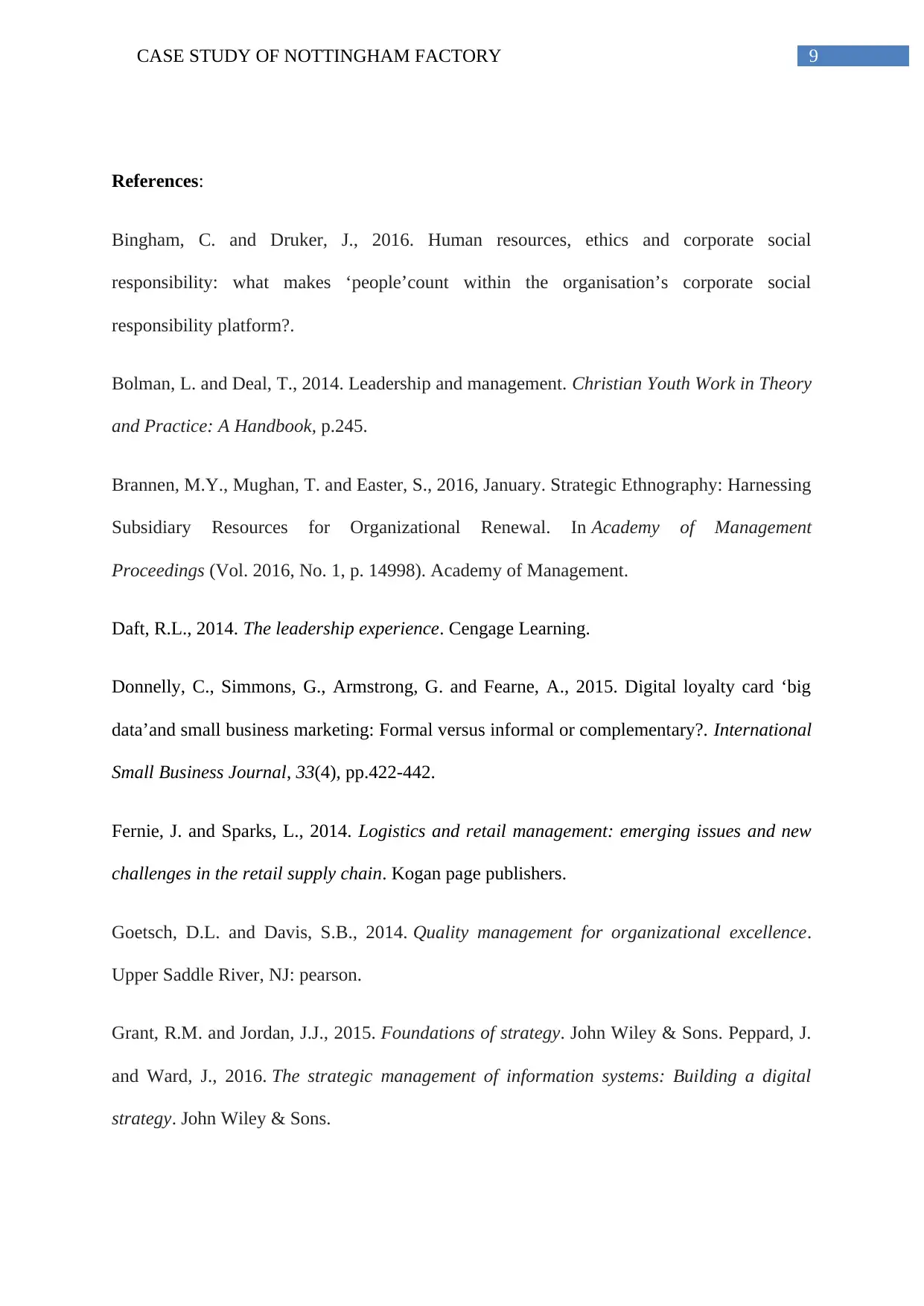
9CASE STUDY OF NOTTINGHAM FACTORY
References:
Bingham, C. and Druker, J., 2016. Human resources, ethics and corporate social
responsibility: what makes ‘people’count within the organisation’s corporate social
responsibility platform?.
Bolman, L. and Deal, T., 2014. Leadership and management. Christian Youth Work in Theory
and Practice: A Handbook, p.245.
Brannen, M.Y., Mughan, T. and Easter, S., 2016, January. Strategic Ethnography: Harnessing
Subsidiary Resources for Organizational Renewal. In Academy of Management
Proceedings (Vol. 2016, No. 1, p. 14998). Academy of Management.
Daft, R.L., 2014. The leadership experience. Cengage Learning.
Donnelly, C., Simmons, G., Armstrong, G. and Fearne, A., 2015. Digital loyalty card ‘big
data’and small business marketing: Formal versus informal or complementary?. International
Small Business Journal, 33(4), pp.422-442.
Fernie, J. and Sparks, L., 2014. Logistics and retail management: emerging issues and new
challenges in the retail supply chain. Kogan page publishers.
Goetsch, D.L. and Davis, S.B., 2014. Quality management for organizational excellence.
Upper Saddle River, NJ: pearson.
Grant, R.M. and Jordan, J.J., 2015. Foundations of strategy. John Wiley & Sons. Peppard, J.
and Ward, J., 2016. The strategic management of information systems: Building a digital
strategy. John Wiley & Sons.
References:
Bingham, C. and Druker, J., 2016. Human resources, ethics and corporate social
responsibility: what makes ‘people’count within the organisation’s corporate social
responsibility platform?.
Bolman, L. and Deal, T., 2014. Leadership and management. Christian Youth Work in Theory
and Practice: A Handbook, p.245.
Brannen, M.Y., Mughan, T. and Easter, S., 2016, January. Strategic Ethnography: Harnessing
Subsidiary Resources for Organizational Renewal. In Academy of Management
Proceedings (Vol. 2016, No. 1, p. 14998). Academy of Management.
Daft, R.L., 2014. The leadership experience. Cengage Learning.
Donnelly, C., Simmons, G., Armstrong, G. and Fearne, A., 2015. Digital loyalty card ‘big
data’and small business marketing: Formal versus informal or complementary?. International
Small Business Journal, 33(4), pp.422-442.
Fernie, J. and Sparks, L., 2014. Logistics and retail management: emerging issues and new
challenges in the retail supply chain. Kogan page publishers.
Goetsch, D.L. and Davis, S.B., 2014. Quality management for organizational excellence.
Upper Saddle River, NJ: pearson.
Grant, R.M. and Jordan, J.J., 2015. Foundations of strategy. John Wiley & Sons. Peppard, J.
and Ward, J., 2016. The strategic management of information systems: Building a digital
strategy. John Wiley & Sons.
Paraphrase This Document
Need a fresh take? Get an instant paraphrase of this document with our AI Paraphraser
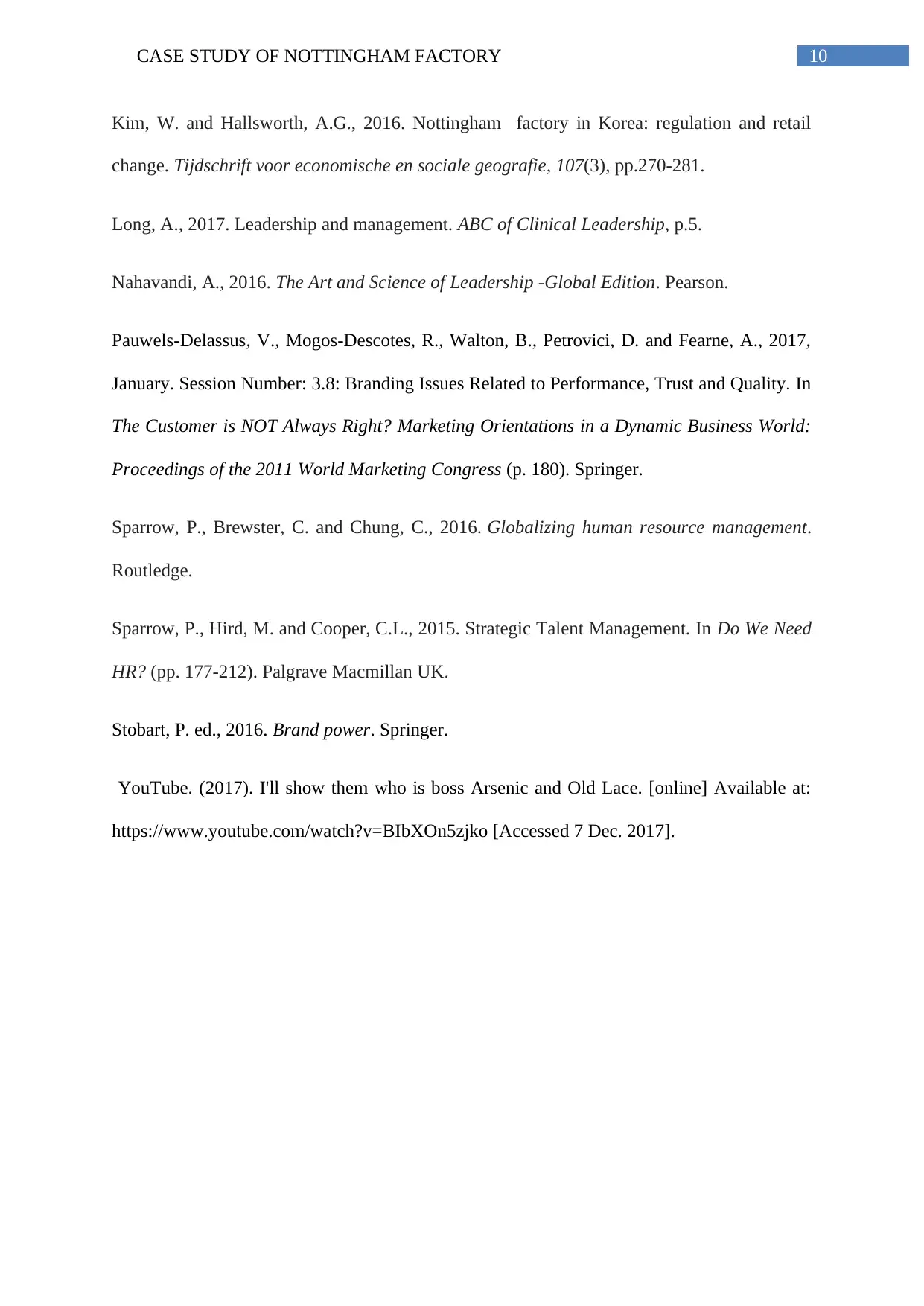
10CASE STUDY OF NOTTINGHAM FACTORY
Kim, W. and Hallsworth, A.G., 2016. Nottingham factory in Korea: regulation and retail
change. Tijdschrift voor economische en sociale geografie, 107(3), pp.270-281.
Long, A., 2017. Leadership and management. ABC of Clinical Leadership, p.5.
Nahavandi, A., 2016. The Art and Science of Leadership -Global Edition. Pearson.
Pauwels-Delassus, V., Mogos-Descotes, R., Walton, B., Petrovici, D. and Fearne, A., 2017,
January. Session Number: 3.8: Branding Issues Related to Performance, Trust and Quality. In
The Customer is NOT Always Right? Marketing Orientations in a Dynamic Business World:
Proceedings of the 2011 World Marketing Congress (p. 180). Springer.
Sparrow, P., Brewster, C. and Chung, C., 2016. Globalizing human resource management.
Routledge.
Sparrow, P., Hird, M. and Cooper, C.L., 2015. Strategic Talent Management. In Do We Need
HR? (pp. 177-212). Palgrave Macmillan UK.
Stobart, P. ed., 2016. Brand power. Springer.
YouTube. (2017). I'll show them who is boss Arsenic and Old Lace. [online] Available at:
https://www.youtube.com/watch?v=BIbXOn5zjko [Accessed 7 Dec. 2017].
Kim, W. and Hallsworth, A.G., 2016. Nottingham factory in Korea: regulation and retail
change. Tijdschrift voor economische en sociale geografie, 107(3), pp.270-281.
Long, A., 2017. Leadership and management. ABC of Clinical Leadership, p.5.
Nahavandi, A., 2016. The Art and Science of Leadership -Global Edition. Pearson.
Pauwels-Delassus, V., Mogos-Descotes, R., Walton, B., Petrovici, D. and Fearne, A., 2017,
January. Session Number: 3.8: Branding Issues Related to Performance, Trust and Quality. In
The Customer is NOT Always Right? Marketing Orientations in a Dynamic Business World:
Proceedings of the 2011 World Marketing Congress (p. 180). Springer.
Sparrow, P., Brewster, C. and Chung, C., 2016. Globalizing human resource management.
Routledge.
Sparrow, P., Hird, M. and Cooper, C.L., 2015. Strategic Talent Management. In Do We Need
HR? (pp. 177-212). Palgrave Macmillan UK.
Stobart, P. ed., 2016. Brand power. Springer.
YouTube. (2017). I'll show them who is boss Arsenic and Old Lace. [online] Available at:
https://www.youtube.com/watch?v=BIbXOn5zjko [Accessed 7 Dec. 2017].
1 out of 11
Related Documents
Your All-in-One AI-Powered Toolkit for Academic Success.
+13062052269
info@desklib.com
Available 24*7 on WhatsApp / Email
![[object Object]](/_next/static/media/star-bottom.7253800d.svg)
Unlock your academic potential
Copyright © 2020–2025 A2Z Services. All Rights Reserved. Developed and managed by ZUCOL.





